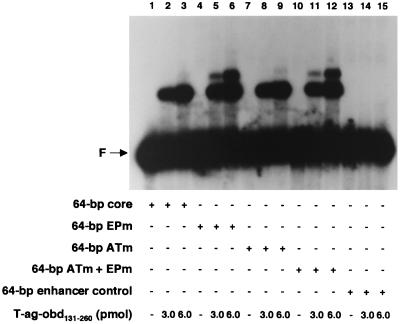FIG. 4.
Gel mobility shift assays used to establish whether mutant forms of the flanking sequences influence T-ag-obd131–260 binding to site II. As a positive control, gel mobility shift assays were conducted with the 64-bp core oligonucleotide and either 3 or 6 pmol of T-ag-obd131–260 (lanes 2 and 3). In related reactions, T-ag-obd131–260 (3 or 6 pmol) was incubated with the 64-bp EPm (lanes 5 and 6), the 64-bp ATm (lanes 8 and 9), the 64-bp ATm + EPm (lanes 11 and 12), or the 64-bp enhancer control (lanes 14 and 15). The reactions in lanes 1, 4, 7, 10, and 13 were conducted in the absence of protein. The input or free duplex DNA (F) is indicated by the arrow. The protein-to-oligonucleotide ratios used in these reactions are given in the legend to Fig. 2. Quantitation with a PhosphorImager revealed that with 6 pmol of T-ag-obd131–260, the percentage of input DNA shifted into the major band shift product formed with the 64-bp core, 64-bp EPm, 64-bp ATm, and 64-bp ATm + EPm oligonucleotides was 22.4, 25.7, 24.0, and 23.1%, respectively.

